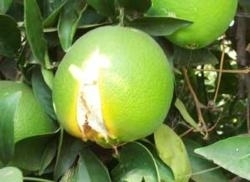These are hard days for navel oranges. Drought stress. Salt stress due to drought. Then a heat wave in July that messed the trees up. And now we head into a weird fall with maybe rain. Maybe no rain. Maybe a little rain. This is ripe for navel splitting. This time of year when they are starting to build sugar, they are also ripe for splitting.
Years of drought, and a stressed tree are a perfect set up for navel oranges and fruit splitting.
The days have turned cooler and suddenly out of nowhere there is rain. That wonderful stuff comes down and all seems right with the world, but then you notice the navel fruit are splitting. Rats! No, a dehydrated fruit that has taken on more water than its skin can take in and the fruit splits. This is called an abiotic disease. Not really a disease but a problem brought on by environmental conditions.
Fruit splitting is a long-standing problem in most areas where navel oranges are grown. In some years, the number of split fruit is high; in other years it is low. Splitting in navel oranges usually occurs on green fruit between September and November. In some years, splitting may also occur in Valencia oranges but it is less of a problem than in navel oranges.
Several factors contribute to fruit splitting. Studies indicate that changes in weather including temperature, relative humidity and wind may have more effect on fruit splitting than anything else. The amount of water in a citrus tree changes due to weather conditions and this causes the fruit to shrink and swell as water is lost or gained. If the water content changes too much or too rapidly the rind may split. In navel oranges the split usually occurs near the navel, which is a weak point in the rind.
Proper irrigation and other cultural practices can help reduce fruit splitting. Maintaining adequate but not excessive soil moisture is very important. A large area of soil around a tree should be watered since roots normally grow somewhat beyond the edge of the canopy. Wet the soil to a depth of at least 2 feet then allow it to become somewhat dry in the top few inches before irrigating again. Applying a layer of coarse organic mulch under a tree beginning at least a foot from the trunk can help conserve soil moisture and encourage feeder roots to grow closer to the surface.
If trees are fertilized, apply the correct amount of plant food and water thoroughly after it is applied. If the soil is dry, first irrigate, then apply fertilizer and irrigate again.
Attached Images:
